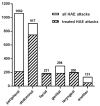Clinical Characteristics and Management of Angioedema Attacks in Polish Adult Patients with Hereditary Angioedema Due to C1-Inhibitor Deficiency
- PMID: 34884311
- PMCID: PMC8658320
- DOI: 10.3390/jcm10235609
Clinical Characteristics and Management of Angioedema Attacks in Polish Adult Patients with Hereditary Angioedema Due to C1-Inhibitor Deficiency
Abstract
Hereditary angioedema (HAE) due to C1-inhibitor (C1-INH) deficiency is a rare disease characterized by recurrent swellings. This study aims to determine (i) the clinical characteristics of the HAE patient population from Poland, and (ii) real-life patients' treatment practices. A cross-sectional study involved 138 adult HAE patients (88 females, 50 males) treated in six regional HAE centers in Poland. Consecutive patients during routine follow-up visits underwent a structured medical interview on the clinical characteristics of the course and treatment of HAE attacks within the last six months. A total of 118 of 138 patients was symptomatic. They reported in total 2835 HAE attacks predominantly peripheral and abdominal, treated with plasma-derived C1-INH (61.4%), icatibant (36.7%) and recombinant C1-INH (1.9%). An amount of 116 patients carried the rescue medication with them while traveling, and 74 patients self-administrated on demand treatment. There were twice as many symptomatic women (n = 78) as there were men (n = 40). Women treated their HAE attacks significantly more often than men. Older patients (≥65 years) reported a longer delay in diagnosis, and practiced the self-administration of rescue medication less frequently in comparison to other patients. Clinical features of the surveyed population are similar to other European, but not Asian, HAE patient groups. Self-administration still remains an unmet medical need. Some distinct HAE patients may require special attention due to the severe course of the disease (females) or a delay in diagnosis (the elderly).
Keywords: C1-inhibitor deficiency; bradykinin-mediated angioedema; emergency; hereditary angioedema; treatment.
Conflict of interest statement
K.P.-W. received a travel grant from CSL Behring; M.B. received a travel grant from CSL Behring; A.J. has served as a speaker for CSL Behring and Takeda; J.J.-B. has served as a consultant for CSL Behring and Takeda; J.G. has served as a speaker for CSL Behring and an a speaker and an advisor for Takeda; K.K. has served as a consultant for CSL Behring and Takeda; R.P. received speaking fees and educational/scientific grants from Takeda/Shire and CSL Behring; G.P. is or recently was a speaker and/or advisor for CSL Behring, Takeda, Pharming, and has served as an investigator for clinical trials sponsored by BioCryst Pharmaceuticals.
Figures
Similar articles
-
Comparing acquired angioedema with hereditary angioedema (types I/II): findings from the Icatibant Outcome Survey.Clin Exp Immunol. 2017 Apr;188(1):148-153. doi: 10.1111/cei.12910. Epub 2017 Feb 9. Clin Exp Immunol. 2017. PMID: 27936514 Free PMC article.
-
Hereditary angioedema with normal C1 inhibitor in a French cohort: Clinical characteristics and response to treatment with icatibant.Immun Inflamm Dis. 2017 Jan 11;5(1):29-36. doi: 10.1002/iid3.137. eCollection 2017 Mar. Immun Inflamm Dis. 2017. PMID: 28250922 Free PMC article.
-
The importance of recognizing and managing a rare form of angioedema: hereditary angioedema due to C1-inhibitor deficiency.Postgrad Med. 2021 Aug;133(6):639-650. doi: 10.1080/00325481.2021.1905364. Epub 2021 Jul 6. Postgrad Med. 2021. PMID: 33993830 Review.
-
Clinical profile and treatment outcomes in patients with hereditary angioedema with normal C1 esterase inhibitor.World Allergy Organ J. 2022 Jan 27;15(1):100621. doi: 10.1016/j.waojou.2021.100621. eCollection 2022 Jan. World Allergy Organ J. 2022. PMID: 35145604 Free PMC article.
-
Management of hereditary angioedema in Japan: Focus on icatibant for the treatment of acute attacks.Allergol Int. 2021 Jan;70(1):45-54. doi: 10.1016/j.alit.2020.07.008. Epub 2020 Sep 9. Allergol Int. 2021. PMID: 32919903 Review.
Cited by
-
Current challenges and future opportunities in patient-focused management of hereditary angioedema: A narrative review.Clin Transl Allergy. 2023 May;13(5):e12243. doi: 10.1002/clt2.12243. Clin Transl Allergy. 2023. PMID: 37227422 Free PMC article. Review.
-
Clinical Characteristics and Quality of Life in a Cohort of Polish Pediatric Patients with Hereditary Angioedema.Children (Basel). 2024 Feb 13;11(2):237. doi: 10.3390/children11020237. Children (Basel). 2024. PMID: 38397349 Free PMC article.
-
Mast cell degranulation and bradykinin-induced angioedema - searching for the missing link.Front Immunol. 2024 May 15;15:1399459. doi: 10.3389/fimmu.2024.1399459. eCollection 2024. Front Immunol. 2024. PMID: 38812508 Free PMC article. Review.
-
The impact of puberty on the onset, frequency, location, and severity of attacks in hereditary angioedema due to C1-inhibitor deficiency: A survey from the Italian Network for Hereditary and Acquired Angioedema (ITACA).Front Pediatr. 2023 Apr 18;11:1141073. doi: 10.3389/fped.2023.1141073. eCollection 2023. Front Pediatr. 2023. PMID: 37144145 Free PMC article.
References
-
- Steiner U.C., Weber-Chrysochoou C., Helbling A., Scherer K., Schmid Grendelmeier P., Wuillemin W.A. Hereditary angioedema due to C1–inhibitor deficiency in Switzerland: Clinical characteristics and therapeutic modalities within a cohort study. Orphanet. J. Rare Dis. 2016;11:43–50. doi: 10.1186/s13023-016-0423-1. - DOI - PMC - PubMed
Grants and funding
LinkOut - more resources
Full Text Sources



